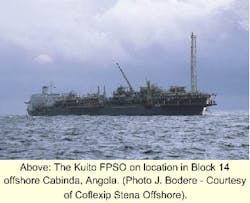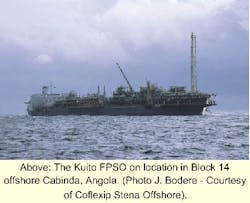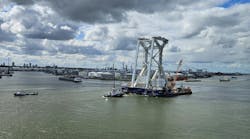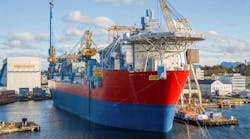First discovered in 1997, the Kuito Field is the initial development in Block 14, offshore Cabinda, Angola. Kuito is a large complex development, occupy ing a position in water depth of about 400 meters. A contract was awarded in September 1998 by Cabinda Gulf Oil Company Ltd., a wholly-owned subsidiary of Chevron Corporation, acting as operator on behalf of a licensee that includes Sonangol, Agip, Total, and Petrogal.
The operators opted for a phased approach to gain field production experience and gather the data necessary to optimize reservoir management. The contracting consortium for Phase 1A - the first phase - brought together ABB, Single Buoy Moorings (SBM), and Coflexip Stena Offshore (CSO). Each consortium partner financed its portion of the 1A Contract until first oil.
Phase 1A began in September 1998, with the Sedco 708 rig drilling and completing 12 subsea production wells that will produce through horizontal trees, jumpers, and a subsea production manifold to the floating production, storage, and offloading (FPSO) vessel. An additional well will serve for re-injection of surplus gas.
In May 1999, this same consortium was awarded Phase 1B, made up of one subsea water injection center, with eight water injection wells, manifold, associated injection line, and a control umbilical to the FPSO. Subsea facilities will be installed immediately after the 1A installation work, with well completion scheduled for early 2000.
For the project, CSO supplied the flexible flowlines, risers, and umbilicals, and carried out the offshore installation operations. The firm's Le Trait plant manufactured the flexible production flowlines and risers and the dual export lines, and the Duco facilities (Newcastle) produced the electro-hydraulic umbilicals and the gas lift risers. Duco (Houston) handled the static portion of the gas lift umbilicals, which were shipped to Newcastle and spliced to the risers. Numerous subcontracts were awarded for the fabrication of permanent equipment, including lazy-S support, buoyancy modules, and bend stiffener fixings for the export lines.
The original offshore installation scenario, sanctioned in 1998, called for the CSO Installer, fitted with a vertical lay system, one carousel and four reels, to shuttle between the field and a heavy lift vessel moored in Pointe Noire, The Congo. The three month installation schedule included three diverless tie-ins to the manifold, using ABB's Icarus tool.
The scenario changed in late spring, 1999, when CSO was tasked with the installation of the 100-ton manifold. A second installation vessel was added and overall offshore work cut down to two months. Then, significant delays in FPSO conversion in Singapore once again modified the critical parameters, shrinking the window between FPSO arrival on site and first oil. However, both the client and contracting consortium wanted to stick to the schedule, and so measures were taken to meet it.
Following the decision, CSO chartered the newly converted DP Smit Pioneer, which has a deck large enough to support a 20-meter diameter carousel capable of carrying the two 15-in. export lines in a single trip. In the summer of 1999, considerable effort was poured into designing and breaking down fail-safe work procedures and sequences for the two installation vessels and reassigning the heavy lift vessel to the transport of the 1B facilities.
Some tricky interfacing of vessel schedules was needed to mitigate the high risk of infield interference between the client drill rig, the FPSO being hooked up, and the CSO vessels.
Offshore operations began in Le Trait in early September 99 with the loading of the 1A facilities aboard the Smit Pioneer. CSO Installer picked up the remainder of the 1A facilities at the end of September. The chartered heavy lift vessel, Jumbo Fairload, picked up the 1B facilities in early October.
Offshore operations proceeded on schedule and were completed on December 1. Smit Pioneer completed the heavy lifts of gravity bases, manifold, and umbilical distribution units. CSO Installer used two Triton(r) XL remotely operated vehicles to do the delicate subsea tie-ins of flowlines and jumpers. 1B facilities were transferred from the Jumbo heavy lift vessel to Smit Pioneer. Their installation, including diver-assisted pull-in under the FPSO was completed in early November, ahead of schedule.
Kuito marks an important step in strategic development in Angola's deepwater. In producing first oil for Cabinda Gulf Oil Company 15 months after award of the contract, it is the fastest cycle time of any project of its kind ever in West Africa.
Kuito's first oil "was achieved under budget and just over 2 1/2 years after its discovery, a remarkable accomplishment," concluded Peter Robertson, President of Chevron Overseas Petroleum Inc.
Acknowledgement
Coflexip Stena Offshore provided much of the timing and contractor activity material, in addition to photographs, for this article.






